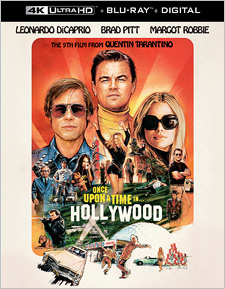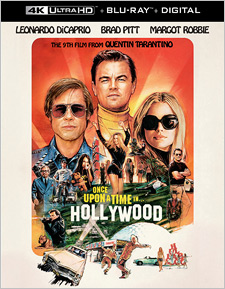Once Upon a Time… in Hollywood (4K UHD Review)

Director
Quentin TarantinoRelease Date(s)
2019 (December 10, 2019)Studio(s)
Columbia Pictures/Bona Film Group/Heyday Films/Visiona Romantica (Sony Pictures Entertainment)- Film/Program Grade: A-
- Video Grade: A-
- Audio Grade: B+
- Extras Grade: B
Review
It’s often said that cinema is language. And the greatest filmmakers—Kubrick, Kurosawa, Ford, Hitchcock, Coppola—use that language to convey meaning, to illuminate theme, or to express larger ideas. But nine films in now, what I’ve never been able to completely determine about Quentin Tarantino is: Is this a filmmaker who is trying to say something, or is he just in love with (and incredibly adept at employing) the many different dialects of cinema language?
Now, I’ve certainly always liked Tarantino and been fascinated by his films, but rarely do I truly love them. This is a director who excels in creating compelling characters and writing crackling dialogue, and he’s made co-opting the techniques of his favorite filmmakers into an art form. But every time I start to think that his madness is working on a higher level, I see another interview with him where he expounds with manic energy about his favorite movies and how much he loved this genre or that, and I doubt my conclusion. Rarely do I see him talking about the themes in his work; he seems completely obsessed with form and style.
If there is an overarching theme to his oeuvre, it seems to be this: Men are real men, or not, women are real women, or not, but life’s a bitch and it all sorts out through violence in the end because that’s who human beings are. We’ve now seen nine films that are essentially variations on this idea. But Once Upon a Time… in Hollywood is different. An unlikely cinematic fairytale that retcons a dark episode in Hollywood history (and also serves as a love letter to its larger place and time), this is Tarantino’s most “meta” film by far.
Tarantino has always used clever choices in casting to inform his work; few true cinephiles can watch Vincent Vega in Pulp Fiction without thinking about the fact that it’s John Travolta in the role. And when Franco Nero sidles up to Jamie Foxx at the bar in Django Unchained, that means something to anyone who loves spaghetti westerns. But here, Taranino is not just playing with film and genre, he’s turned his lens on cinema itself, and at a critical moment in cinema history no less, just as the old Hollywood studio system is collapsing and “New Hollywood” (or the American New Wave) is on the rise. That can be no accident. Once Upon a Time… in Hollywood is also, we’re meant to believe, Tarantino’s penultimate work. So is he, at long last, subverting his own work—his own aforementioned theme—to say something more meaningful and profound?
Interestingly, some fans have knocked this film for being too boring and for its lack of violence. A few critics have also called this film out for seeming to celebrate the misogyny of its leads. Indeed, when the violence does finally erupt, it’s directed at a trio of Manson family hippies, two of whom are women. Granted, the trio are nitwits, but still… the level of violence is nothing if not excessive. In fact, it’s downright overkill—exactly what we’ve come to expect from Tarantino.
But there’s another reading of the film that must be considered too: The two male leads, has-been Western actor Rick Dalton and his out-of-work stunt double Cliff Booth, are unquestionably losers. They’re relics, products of another time, struggling to deal with the fact that both society and the business of Hollywood itself are moving beyond them. Dalton is an insecure mess and Booth now basically works as his driver and personal assistant. Both are alcoholics who spend their evenings self-medicating and reliving their glory days. And it’s strongly implied that Booth killed his wife and got away with it. But by casting two of today’s biggest Hollywood leading men—Leonardo DiCaprio and Brad Pitt—in those roles, it’s hard to avoid the conclusion that Tarantino is saying something deeper about celebrity and hero worship. Indeed, there’s even a scene in which Pitt (as Dalton) is fetishized in the “inglourious” act of repairing the TV antenna on Dalton’s roof. And when Dalton is ultimately confronted with real-life danger, he seems impotent to respond until he reacts instinctively as one of his characters once did in a movie—by grabbing a flame thrower.
Conversely, much has been made of the fact that Margo Robbie has few lines of dialogue in Once Upon a Time… in Hollywood. But Robbie’s Sharon Tate is the most hopeful character in this film. Her simple delight in the act of seeing herself on screen, and relishing in the audience around her reacting positively to her performance, is a joy to behold. It’s pure, honest, and easy for the audience to connect with. It can also be no accident that the smartest character in this film is an 8-year-old girl, who, with the smartest dialogue in the film, proceeds to reduce DiCaprio’s Dalton to a needy blubbering mess not once but twice. Clearly, there’s something different going on here.
Consider too that Tarantino’s tenth and (possibly) final film could be his long-rumored Star Trek project. Now, Star Trek is a franchise that’s deeply associated with optimism about the future; with the idea of humanity transcending its own shortcomings and worst instincts to reach its full potential. And Tarantino has never made a science fiction film. Could it be that his plan all along has been to march through cinema history and—ultimately—to say something more profound? If he is, he’s a genius. Or… maybe there’s no plan at all. To quote longtime Bits columnist Todd Doogan, “Tarantino films are like a Rorschach test. Critics read meaning into his films that he takes credit for it afterwards.” But isn’t the fact that his films lend themselves to that sort of reading evidence of a kind of genius too? Of course, it is. But which is it? The honest truth is, I can’t completely decide. And that, in a nutshell, is the fascinating conundrum that is Quentin Tarantino. It’s why, love him or hate him, you simply can’t ignore him.
Once Upon a Time… in Hollywood was shot mostly on 35 mm, with a bit of 16 mm and even 8 mm film employed too, using a variety of cameras and lenses. It was finished as a native 4K Digital Intermediate at the 2.39:1 scope ratio (though several clips and segments are presented in 1.85 or 1.33 within the film). For its Ultra HD release, the film has been graded for High Dynamic Range (HDR10 is included here). The resulting image is crisp, refined, and satisfying—a notable bump in detail from the regular Blu-ray presentation. The photochemical grain structure is subtle but pleasing, rendering a lovely cinematic texture. The HDR grade is actually quite restrained; shadows are deep-ish but occasionally a little gray, while the highlights have added pop yet fall short of being eye reactive. Still, there’s a bit of detail gained at both extremes. And the color palette is rich and naturalistic, though often stylized to mimic the look of vintage film, or to more strongly evoke the film’s period 70s Hollywood environs. Visually, this is a lovely presentation.
Primary audio on the 4K disc is included in English 7.1 DTS-HD MA. Once Upon a Time… in Hollywood is a largely dialogue-driven film, but that dialogue is clean and presented with good clarity. The rest of the film’s mix is made up of environmental sound cues and period music and radio clips, with occasional moments in which the mix seems to collapse into mono during recreations of vintage TV broadcasts. That aside, the soundstage is medium-wide, with plenty of atmospheric surround cues, and the odd bit of panning and movement. LFE is natural and adequate. This mix certainly isn’t going to give your speakers a workout, but it’s exactly as good as it needs to be and is a fine complement to the visuals. Additional audio options include English Descriptive Audio and 5.1 Dolby Digital in Czech, French, French Descriptive Audio, Hungarian, Korean, Polish, Portuguese, Russian, Spanish, and Thai. Optional subtitles are available in English, English SDH, Arabic, Bulgarian, Cantonese, Simplified Chinese, Traditional Chinese, Croatian, Czech, Estonian, French, Greek, Hebrew, Hungarian, Icelandic, Indonesian, Korean, Latvian, Lithuanian, Polish, Brazilian Portuguese, Portuguese, Romanian, Russian, Serbian, Slovak, Slovene, Spanish, and Thai.
Sony’s 4K disc itself includes only one extra, but it’s a good one:
- Additional Scenes (7 scenes – 24:01 in all)
Much of this is footage shot for the film but only seen briefly in the final cut. It includes Old Chattanooga Beer and Red Apple cigarette TV commercials, Rick Dalton’s complete Hullabaloo performance, the full teaser and opening to Bounty Law, additional footage of Luke Perry as Wayne Maunder, a bit more of Damon Herriman as Charlie Manson (that includes a brief brush with Cliff), and Rick and his Lancer director talking shop on set. Best of all, these scenes are in full 4K with HDR.
The Blu-ray Disc in this package also includes those scenes and adds the following in HD:
- Quentin Tarantino’s Love Letter to Hollywood (5:00)
- Bob Richardson: For the Love of Film (4:34)
- Shop Talk: The Cars of 1969 (5:58)
- Restoring Hollywood: The Production Design of Once Upon a Time… in Hollywood (9:18)
- The Fashion of 1969 (6:37)
The featurettes are all relatively short, though they do at least feel substantial. Of all of them, I actually really liked the Shop Talk piece, about the period cars used in the production, and the Restoring Hollywood piece, about the effort to recreate 1969 Hollywood (including four full blocks of Hollywood Boulevard). Again, they’re brief but good stuff and all worth viewing. Naturally, you also get a Movies Anywhere Digital code on a paper insert.
Once Upon a Time… in Hollywood is a fascinating film. I wouldn’t call it Tarantino’s best (for me, that would be Pulp Fiction or Jackie Brown). Nor would I quite call it a masterpiece. But it is, I think, his most interesting and personal piece of work. Here, more than ever before, Tarantino seems to be trying to say something. Or not. Either way, the director’s characteristic attention to detail, dialogue, character—and his trademark love of cinema and this time period of L.A. in particular (the epicenter of his own childhood)—are on full display in Once Upon a Time… in Hollywood. And you simply can’t ignore it. Highly recommended.
- Bill Hunt
(You can follow Bill on social media at these links: Twitter and Facebook)

